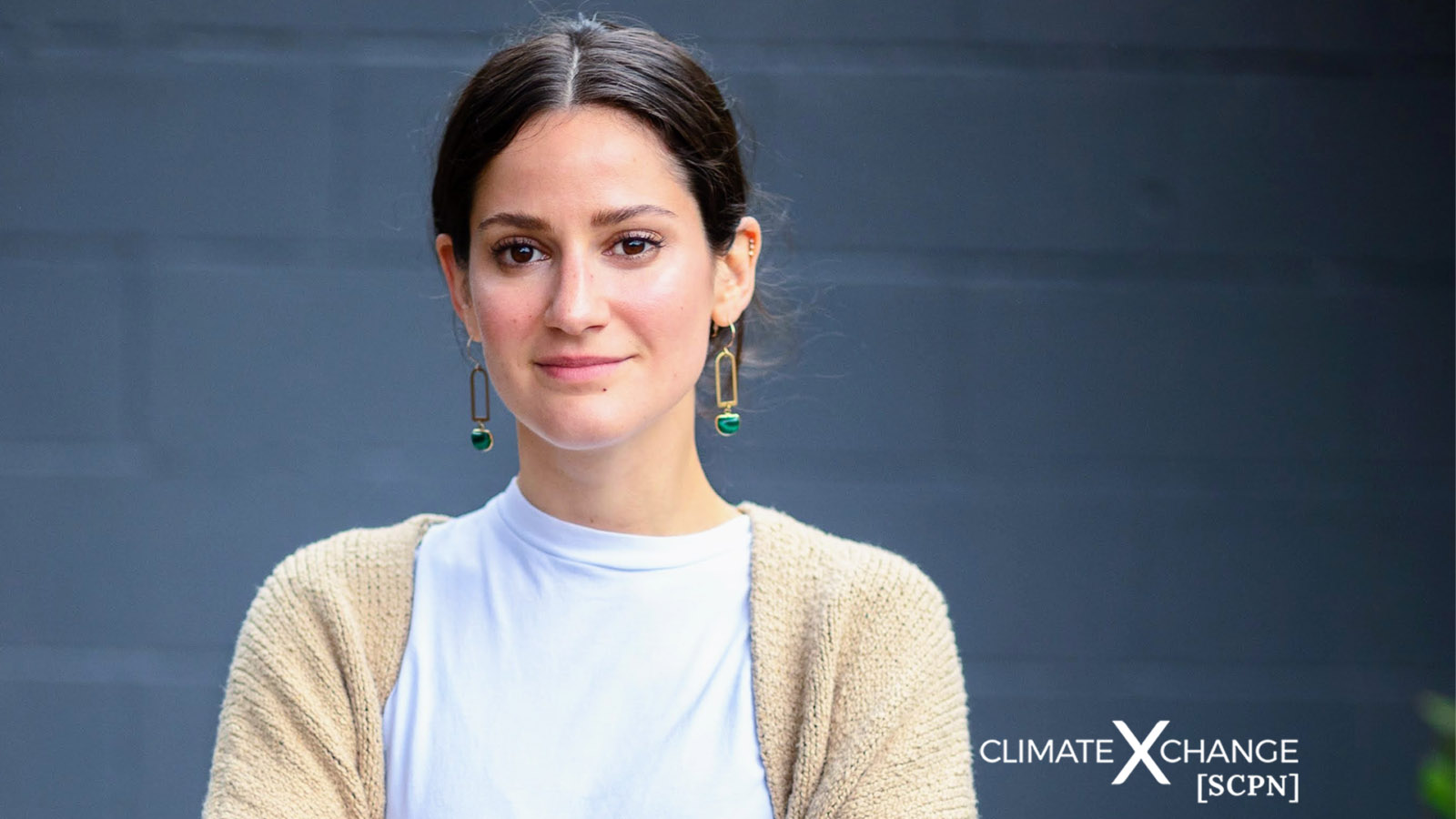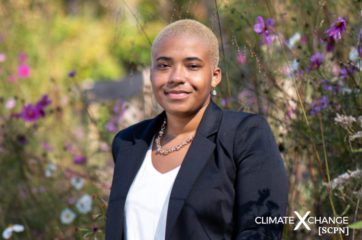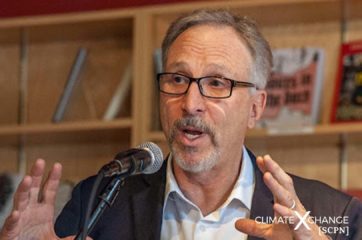All across the country, members of our State Climate Policy Network (SCPN) are fighting to make an impact on climate change in their communities. We have individuals in our Network from all 50 states, each experiencing climate change differently in their local areas and finding unique solutions to build resiliency efforts.
Nora Apter is the Climate Program Director for the Oregon Environmental Council where she focuses on grassroots activism and community building in the climate movement. Prior to her role with the Oregon Environmental Council, Apter worked on federal policy as the Deputy Director of Federal Affairs for the Natural Resources Defense Council (NRDC), where she directed the development and implementation of federal legislative strategy on policy issues including the protection of public lands, wildlife and oceans from climate change-causing resource extraction. An Oregon native, Apter also worked for Oregon’s Senior Senator Ron Wyden. She holds a B.A. in International Affairs and Economics from Lewis & Clark College in Portland.
This interview has been lightly edited for clarity and brevity.
Melanie Mathewson: Can you tell me a little bit about yourself and what your role is at the Oregon Environmental Council (OEC)?
Nora Apter: I’m originally from the Portland area of Oregon, and I have a background in policy. I have spent the majority of my career at the federal level, but was really interested in coming back to Oregon to work on climate advocacy at the state level. I had been tracking the clean energy jobs effort for some time, which was the campaign to pass the Cap-and-Invest bill through the legislature. I was paying attention to the momentum and the coalition effort from afar, and then came into my current position with OEC in March of last year. I had anticipated that this role would, at least initially, be really focused on the continuation of that legislative effort. But, just a couple days after I started, the governor signed an Executive Order (EO) on climate — EO 20-04, also known as the Oregon Climate Action Plan — which really is sweeping executive action on climate.
Resulting from that EO, multiple ongoing rulemakings are happening across many different state agencies focused on implementing the order. I mention that because it’s shifted, or at least added, to the portfolio on what this job is about. My role is still focused on how we are making progress in the legislature on climate, but also how we are making sure that we maintain grassroots energy and activism through the rulemaking process, which we know is so key to effective implementation of climate policy. My role has been focused on coalition coordination and management; and making sure that our network of grassroots activists are kept apprised of opportunities to engage through the administrative rulemaking process, and that we’re getting the best possible outcomes through those processes for climate as well as for equity. It’s kind of dual-part policy development – keeping track of and representing OEC in various climate rulemaking processes, and helping to shape the legislative agenda in partnership with our environmental justice, labor, and other climate partners – and extensive coalition work.
Melanie Mathewson: Your role definitely changed from what you originally thought it was going to be because of the passing of EO 20-04, correct?
Nora Apter: It did in many ways. OEC has always been one to follow through and engage deeply in the administrative rulemaking process. For instance, with the Clean Fuels Program, my predecessor was, and continues to be, key in the ensuring effective implementation of that program through rulemaking. So, rulemaking engagement was always expected to be part of my role, =but I think the impact that the EO had on the structure and substance of the Oregon climate coalition advocacy work was not anticipated.
Melanie Mathewson: You mentioned moving from the federal to the state level last year. What was that change like for you, and what have been some of the biggest differences you’ve experienced?
Nora Apter: That’s a really good question. In transitioning from the federal to the state level, I’ve been surprised by how much is similar. Well, there’s a lot of differences and there’s a lot of similarities, but I’ll start with what’s similar. I’m from Oregon and I worked for Senator Wyden for some time, so I felt like I gained a better understanding of the variety of perspectives across the state; and specifically how different parts of Oregon are relating to our changing climate and drawing the connections between the wildfires,excessive heat,drought, and the need for climate protections. I felt like my background gave me that understanding in terms of the diversity of perspectives, but you know it’s definitely much more apparent working on the ground at the state advocacy level.
In particular, unfortunately, climate has continued to be a really partisan issue in Oregon. Of course that is the case at the federal level, but I’ve been really glad to see in the 117th Congress and the new administration a real willingness to be bold on climate and not really shy around the need for urgent action and near term emissions reductions. I’m hopeful that trickles down to the state level, but I think the fact that climate is still so polarizing makes it really tricky for leaders in Oregon to take that same approach.
Melanie Mathewson: With the mix of perspectives and backgrounds, Oregon is such an interesting place to work on policy. You don’t have people who are similar across the region like you might in some other states, so I’m not surprised that this has presented a challenge.
Nora Apter: Exactly. The other thing that is different is that I transitioned to this role while the Trump administration was still in power, and at the federal level, we played many, many years of defense, just trying to hold the line against attacks on our cornerstone environmental laws and really egregious rollbacks of climate protections. It’s definitely been a positive change to work with the diverse coalition that we have here on proactive advocacy, which is definitely a huge part of what attracted me to this position. We’ve seen just recently how effective that can be with the passage of 100% Clean, and again some of the rulemaking outcomes and other agency decisions that have already come to fruition through the implementation of the Executive Order.
Melanie Mathewson: What is in EO20-04 and what are the changes that have been part of it since it started?
Nora Apter: I will do my best to be brief. The reason I include that caveat is because it really is sweeping. The EO covers everything from directing our building codes to be more efficient to increasing carbon sequestration on our natural and working lands, to reducing emissions from transportation by prioritizing climate-smart investments, expanding our clean fuels program, and advancing electrification. One of the big rulemakings resulting from the EO that we’re engaging in right now is a new program to cap and reduce emissions from our largest polluters in Oregon. This includes large stationary sources, transportation fuels, and natural gas. Another area that we’re working on is with the Public Utility Commission, which regulates Oregon’s utilities, and really honing in on what the clean energy future looks like for Oregon and how we get there.
There are also directives on health. We’re working with Oregon OSHA (Occupational Safety and Health Administration) to adopt new standards to protect workers from excessive heat and wildfire smoke; and we’re working with the Oregon Health Authority which, under the EO, is now directed to put out an annual report specifically focused on how climate is impacting and worsening public health crises in Oregon, as well as the impacts on youth mental health.
There’s a lot within the order, but those are the six main buckets. If you were to encapsulate it into three main things, the EO: sets new greenhouse gas emissions reduction goals for Oregon; requires all state agencies to help implement those goals by prioritizing climate and emissions reductions in decision-making; and includes specific directives to state agencies. Those were some of the examples I just gave, so not simply prioritizing climate decision making, but also directing specific actions and programs to be adopted in support of our climate goals.
Melanie Mathewson: I can tell why your job description was shifted to focus on the implementation of EO 20-04 — that’s a lot. Oregon is very diverse in the people that live there, and I know that the Indigenous populations are a really important voice in the climate movement. How is OEC working with those groups as well as other marginalized communities?
Nora Apter: Something really important to note, as far as how the coalition effort has shifted, is recognizing that we need to have a robust coalition effort to support the implementation of this EO and get the best outcomes through these rulemakings.
We set up a new steering committee focused on implementation, as well as individual issue area tables focused on the six big bodies of work related to the Executive Order’s directives. For each table, there is a more traditional climate or environmental organization that co-leads with an environmental justice organization. The intention is to ensure that equity and vulnerable communities are centered in our advocacy, so any communication that’s going into an agency, any review that we’re doing of rules that come out, we want to make sure that our state decision makers are really following through with their public mandate to prioritize and alleviate burdens from those who have been historically and disproportionately impacted from climate change and fossil fuels.
This was really intentional in this structure. To name a few examples, I mentioned the Cap and Reduce Program, which is a rulemaking that we have a table focused specifically on. I’m currently the climate-representing co-lead of that table along with one of our longtime partners, Don Samson, who’s with the Affiliated Tribes of Northwest Indians. Don has been a critical partner for many years that goes far beyond my time here, but with cap-and-reduce, he’s done an excellent job of making sure that tribal input is prioritized as the Department of Environmental Quality moves forward with this rulemaking process. He, thankfully, has a seat on the Rulemaking Advisory Committee along with some other tribal representatives, and he has been vital in making sure that they’re kept apprised of decision points in the rulemaking process.
I’m very grateful for that partnership. And likewise, as another example, I mentioned some of the public health directives. OEC is co-leading the health table work around those directives with PCUN (Pineros Y Campesinos Unidos del Noroeste), a farm worker advocacy organization that has also been a longtime partner of OEC’s. Again, a top priority with the Oregon OSHA rulemakings to protect workers has been making sure that those voices are front and center in shaping those rules. We are also working with public health experts, of course, but really making sure that workers’ voices and experiences are front and center.
Melanie Mathewson: I watched the OEC’s introduction video and I could tell there were so many different perspectives and people, and it made me excited to talk to you about how the organization is centering equity in climate advocacy. Environmental justice isn’t always prioritized or centered in climate policymaking, so it is refreshing to see OEC isn’t shying away from incorporating these critical perspectives. Exploring further on the website, on your staff biography page I noticed you have an Audre Lorde quote that reads: “There’s no such thing as a single-issue struggle because we do not live single issue lives.” Why did you choose that quote and what does it mean to you?
Nora Apter: That quote is, at its core, about intersectionality. I’ve always viewed the environmental movement, and specifically the movement around climate justice, as something that has the potential to impact all of our lives and community members, and specifically those who have been disproportionately impacted by environmental and climate harms. It’s the freeway that was built through a primarily BIPOC (Black, Indigenous, and People of Color) community. It’s the toxins that are dumped into water, it’s lead pipes that are not being fixed. I think it’s very important that we recognize that more privileged communities have not historically been and are not going to be the ones that are facing the worst impacts. By reducing emissions, you also improve public health outcomes for those communities on the frontlines of climate pollution; and you create good paying jobs that support families. Climate is very much a cross-sectional issue.
I think that the COVID crisis has made that even more clear. We know that climate has made COVID outcomes even worse, specifically within BIPOC populations. We’ve seen how health impacts are continuously widening in terms of who is able to access healthcare and protect themselves. This is not just COVID, it’s climate change and the implications of it that we continue to face every day.
The same goes for the impacts that we’re seeing from the climate in Oregon right now. It’s our frontline workers that are having to choose between their paycheck and whether they’re exposing themselves to these really dangerous climate hazards. There are rural Oregonians, farmers and agricultural community workers, who are having to face declining productivity due to drought and land and crop loss due to fires and smoke damage. I think [climate change] really touches all aspects of our lives and we’ll only continue to see those impacts even more. Everybody should be concerned.
Melanie Mathewson: Climate XChange published an article last year that I think relates closely to what you’re touching upon. It addressed how, during the height of the pandemic, air conditioner availability and the increased presence of heat waves impacted each other in a way many people hadn’t thought of. People living in buildings without central air or those who can’t afford the high price of an air conditioning unit would usually go into an indoor public space where there was air conditioning. Because of COVID-19, either there were space capacities restricting how many people can come in or all of these public places are closed. This left people without access to these products and facilities and nowhere to go to relieve themselves from the heat. It’s the compounding of these environmental justice issues that people don’t put together, but they’re more apparent to those living this reality. Unfortunately, there are many more of these situations than you and I are aware of, so it is vital we listen to the perspectives of those most affected by it.
The last question I had is a fun one. If you had a magical policy wand that could implement any climate related policy, what policy would you choose and why?
Nora Apter: Wow, that’s a great question. I think I’m going to pick a real-life example, and hopefully Climate XChange will appreciate this. I think that the American Jobs Plan is an unprecedented opportunity and exactly the solution we should be talking about to address a cross-sectional issue. We know that we have the opportunity through the American Jobs Plan to create good paying, family wage jobs that can’t be exported. We have the opportunity to reduce emissions from our electricity sector, which we know is critical to transition to a clean energy economy. And we have the opportunity to support a much cleaner, more equitable, and more efficient way of getting around, which is by investing in public transportation as well as making sure that we’re transitioning to 100 percent electric vehicles, because we know that, in Oregon, transportation equates to 40 percent of our emissions. And we have the opportunity to prioritize all of these investments in BIPOC, low-income, and rural communities on the frontlines of climate change.
I view the American Jobs Plan as the cross-sectional approach that we need and one that supports an equitable economic recovery which will help ensure that our communities are more resilient, especially as we’re considering the ongoing health crisis. And again, it takes a cross-sector approach to address climate change because there isn’t a one size fits all policy solution. I really think that building back better is exactly the kind of mindset that we should all be in. We know that we can’t return to normal. We can’t afford to do that.









